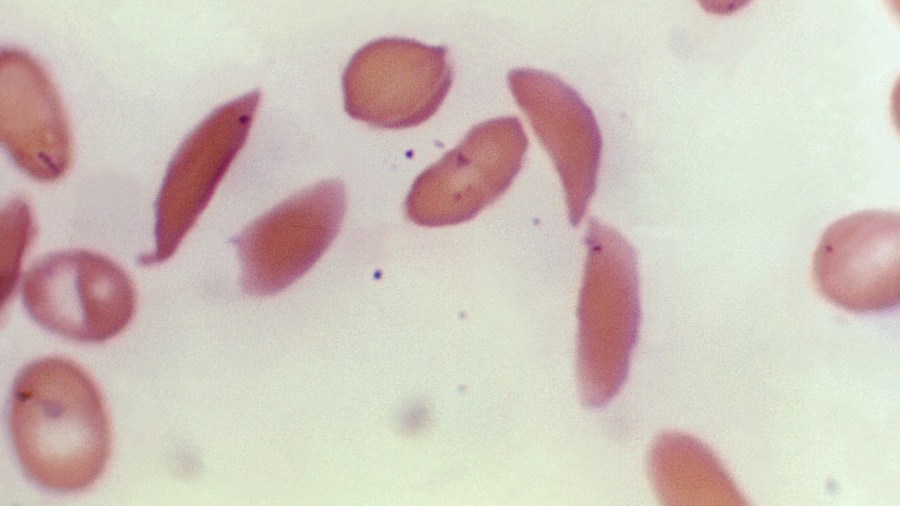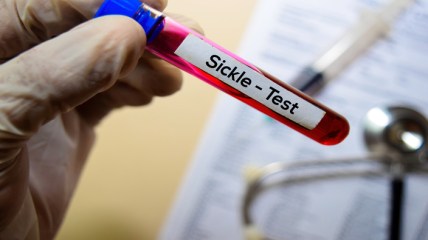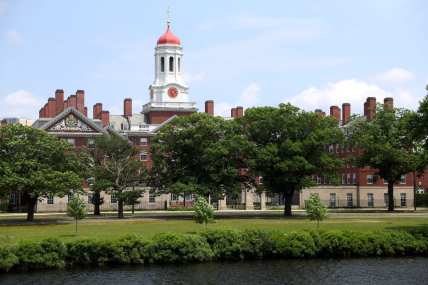A new cure for sickle cell disease may be coming. Health advisers will review it this week
If approved by the FDA, it would be the first gene therapy on the U.S. market based on CRISPR, the gene editing tool that won its inventors the Nobel Prize in 2020.
The only cure for painful sickle cell disease today is a bone marrow transplant. But soon there may be a new cure that attacks the disorder at its genetic source.
On Tuesday, advisers to the Food and Drug Administration will review a gene therapy for the inherited blood disorder, which in the U.S. mostly affects Black people. Issues they will consider include whether more research is needed into possible unintended consequences of the treatment.
If approved by the FDA, it would be the first gene therapy on the U.S. market based on CRISPR, the gene editing tool that won its inventors the Nobel Prize in 2020.

The agency is expected to decide on the treatment in early December, before taking up a different sickle cell gene therapy later that month.
Dr. Allison King, who cares for children and young adults with sickle cell disease, said she’s enthusiastic about the possibility of new treatments.
“Anything that can help relieve somebody with this condition of the pain and the multiple health complications is amazing,” said King, a professor at Washington University School of Medicine in St. Louis. “It’s horribly painful. Some people will say it’s like being stabbed all over.”
The disorder affects hemoglobin, the protein in red blood cells that carries oxygen. A genetic mutation causes the cells to become crescent-shaped, which can block blood flow and cause excruciating pain, organ damage, stroke and other problems.
Millions of people around the world, including about 100,000 in the U.S., have the disease. It occurs more often among people from places where malaria is or was common, like Africa and India, and is also more common in certain ethnic groups, such as people of African, Middle Eastern and Indian descent. Scientists believe being a carrier of the sickle cell trait helps protect against severe malaria.
Current treatments include medications and blood transfusions. The only permanent solution is a bone marrow transplant, which must come from a closely matched donor without the disease and brings a risk of rejection.
No donor is required for the one-time gene therapy, “exa-cel,” made by Vertex Pharmaceuticals and CRISPR Therapeutics. This new treatment involves permanently changing DNA in a patient’s blood cells.
The goal is to help the body go back to producing a fetal form of hemoglobin — which is naturally present at birth but then switches to an adult form that’s defective in people with sickle cell disease.
When patients undergo the treatment, stem cells are removed from their blood and CRISPR is used to knock out the switching gene. Patients get medicines to kill off other flawed blood-producing cells and then are given back their own altered stem cells.
The treatment has been tested in a relatively small number of patients thus far, the nonprofit Institute for Clinical and Economic Review said in an evidence report.
In a briefing document released Friday before the advisory committee meeting, Vertex said 46 people got the treatment in the pivotal study. Of 30 who had at least 18 months of follow-up, 29 were free of pain crises for at least a year and all 30 avoided being hospitalized for pain crises for that long.
The company called the treatment “transformative” and said it has “a strong safety profile.”
Victoria Gray, of Mississippi, the first patient to test the treatment, shared her experience with researchers at a scientific conference earlier this year. She described suffering with terrible bouts of pain since childhood and receiving high-dose pain medications and sometimes blood transfusions. She described feeling she “was being reborn” the day she got the gene therapy.
Now, she’s able to run around with her kids and work a full-time job. “My children no longer have a fear of losing their mom to sickle cell disease,” she said.
But the FDA is asking an outside panel of gene therapy experts next week to discuss a lingering issue that often comes up when discussing CRISPR: the possibility of “off-target effects,” which are unexpected, unwanted changes to a person’s genome. The FDA is looking for advice on whether the company’s research on such effects was adequate to assess the risk or whether additional studies are needed. While the agency doesn’t have to follow the group’s advice, it often does.
If the treatment is allowed on the market, the company has proposed a post-approval safety study, product labeling outlining potential risks and continuing research.
The FDA is expected to decide on the second gene therapy for sickle cell, made by Bluebird Bio, before the end of the year. Bluebird’s treatment works differently. It aims to add functional copies of a modified gene, which helps red blood cells produce “anti-sickling” hemoglobin that prevents or reverses misshapen cells.
The companies have not released potential prices for either therapy, but the institute report said prices up to around $2 million would be cost-effective. By comparison, research earlier this year showed medical expenses for current sickle cell treatments, from birth to age 65, add up to about $1.6 million for women and $1.7 million for men.
King, the St. Louis doctor, acknowledged the new treatments would be expensive. “But if you think about it,” she said, “how much is it worth for someone to feel better and not be in pain and not be in the hospital all the time?”
TheGrio is FREE on your TV via Apple TV, Amazon Fire, Roku and Android TV. Also, please download theGrio mobile apps today!



